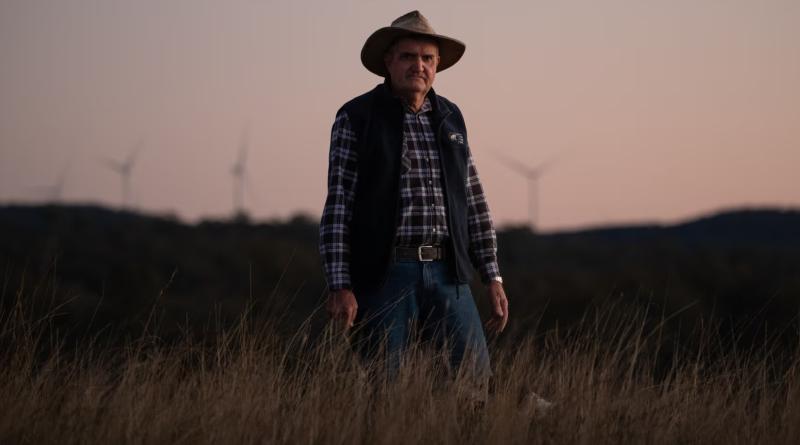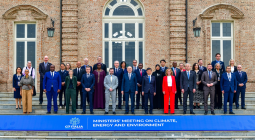In the largest windfarm in the southern hemisphere, ‘renewable energy farmers’ look to the future

You can see 119 wind turbines scattered across the landscape from the highest point on sheep grazier Brent Finlay’s southern Queensland property. Within a few months, there will be 162; within a decade, with another gigantic project proposed next door, about 350.
And that’s just to the north. In every other direction, Finlay says with a sweep of his hand, wind developers are knocking on farmers’ doors.
“People either like wind turbines or they don’t like them. It’s quite polarising,” says Finlay, once president of the National Farmers’ Federation and now chair of the government’s centrepiece drought policy, the Future Drought Fund. He says the view “doesn’t really worry me”.
At least 30 turbines are located on Finlay’s land. For him and the nine other landowners hosting the MacIntyre windfarm, it is a financial lifeline.
The project is the largest onshore windfarm in the southern hemisphere and covers about 36,000 hectares of rocky grazing country south of the rural town of Karara, about 200km south-west of Brisbane. Five years ago it suffered its worst drought in living memory.
“Income diversification is critical for long-term survival in Australian agriculture,” Finlay says. “What we hear in the predictions are larger droughts, longer droughts, deeper droughts into the future.”
Governments may have their sights on renewable energy – critical for reducing reliance on fossil fuels in order to curb the worst of global heating – but for farmers, it’s more about surviving it at all.
The deal struck by the group of landowners and the windfarm’s developer, Spanish renewable energy giant Acciona, is confidential, but lobby group Farmers for Climate Action has said annual payments to farmers average $40,000 a turbine.
That estimate would put total compensation, shared between the 10 landowners, at $162m over the project’s 25-year lease agreement. It is a potentially significant additional income alongside earnings from their wool and meat operations that can coexist with turbines humming overhead.
Finlay calls himself a “renewable energy farmer”, but not everyone is convinced.
What about the neighbours?
“Everyone over there has got turbines and I don’t begrudge that,” says grazier Scott Tait.
Tait runs cattle on a property at Karara but lives outside the area. “If we were offered the opportunity to host turbines I suppose we’d take it too,” he says.
From a hill on his property, which Tait says he planned to build a house on, the blades of half a dozen MacIntyre turbines poke above a distant stand of eucalypts. Tait says Acciona representatives assured him the turbines wouldn’t be visible from his house site.
The new development on Acciona’s books, Herries Range, will see turbines built in the other direction. The rapidly expanding landscape of steel towers and fibreglass blades that stretch 285m into the sky has left Tait saying he feels powerless. And unlike his neighbours who host turbines, he had not received any compensation.
It is this group of people – neighbours, not hosts – who are showing a growing resentment toward the renewable energy boom. French energy company Engie this week announced a plan to offer a $1,000 rebate on energy bills to those who live near its solar and wind developments in an effort to build support.
“If this is the way we have to go, if this is the future, there needs to be a better system of taking into account the impact on small rural communities,” Tait says.
In a statement, an Acciona spokesperson said Tait’s land is more than 5km from the nearest turbine and the company will continue to engage with him about his concerns while “discussing potential impact and mitigation”.
Mitigating the impact on rural communities is a concern in renewable energy developments across the country, says former national energy infrastructure commissioner Andrew Dyer. Neighbour agreements – compensation for landowners who don’t host turbines themselves but are close to properties that do – can allay concerns.
“It means neighbours can then be part of the winning team rather than the losing team,” Dyer tells Guardian Australia.
A review authored by Dyer found Australia’s renewable energy rollout had created a “material distrust” of energy developers due to a lack of community engagement. The government has committed $20.7m to implementing its recommendations.
“It’s the fear of the unknown that often drives tension and concern, that’s fair enough, we’d all be concerned,” Dyer says. Decreases in the land value of neighbouring properties is another major concern, but there is “limited to no evidence” this eventuates, he says.
Down the road from the windfarm, Elizabeth and Andrew Galeraith are renovating the Karara taven & motel which they bought last month. The roadside pub’s revenue has tripled since construction began.
“If you want the area to grow and develop, then MacIntyre has been really positive,” Andrew says. “If you want it to stay as a small rural community, then it’s not. It depends on your values … we want it to thrive.”
A new battleground
Two weeks ago, about 50 people gathered into a community centre in Greymare, Queensland in opposition to a prospective windfarm in the area. Among the crowd were state Liberal MP James Lister, who took their concerns to parliament.
Unlike the vast land holdings that host the MacIntyre windfarm, Greymare is dotted with retirees and tree-changers on small hobby farms.
The meeting was organised by Rose Uwins and Lindy Bennett, who moved to the area from Melbourne. “We have not had one iota of consultation, we have not been able to have a say, we have not been able to have an opinion,” Bennett says.
It’s not the only community with concerns: last week the South Burnett regional council unanimously called for a moratorium on renewable energy projects until strict conditions are met.
Opposition to renewable developments ranges from the lack of consultation and the visual impact to the localised environmental impacts, increases in traffic and increased pressure on an already stretched rental market.
MacIntyre’s construction workforce peaked at about 750 last year. The majority lived in an on-site workers’ camp, but some lived in the nearby town of Warwick in the Southern Downs regional council. The mayor, Melissa Hamilton, says it has had an impact on housing availability.
“A lot of families who could afford rent before have found themselves homeless,” she says.
Wind developers are required to pay rates to local councils of roughly $10,000 per turbine. According to Acciona, the MacIntyre project has so far poured $678m into Queensland businesses, will employ up to 40 people and distribute $250,000 in community grants annually once operational and is supported by 58% of locals. The company said they could “learn from” the housing issue.
At Greymare, some locals who have watched the MacIntyre development are arguing in support of the economic benefit of hosting a windfarm in their community, too.
From a ridge on David Lawler’s Greymare property, the silhouettes of MacIntyre’s wind turbines pierce the horizon like matchsticks. Lawler is one of about 25 farmers in early talks with a renewable energy developer.
Hosting turbines would make for a comfortable retirement for Lawler, a secure income for his two sons and potential local jobs.
“Not everyone wants their kids to have to go away and work,” Lawler says. “We’ve got to think of the benefit to the whole community.”





